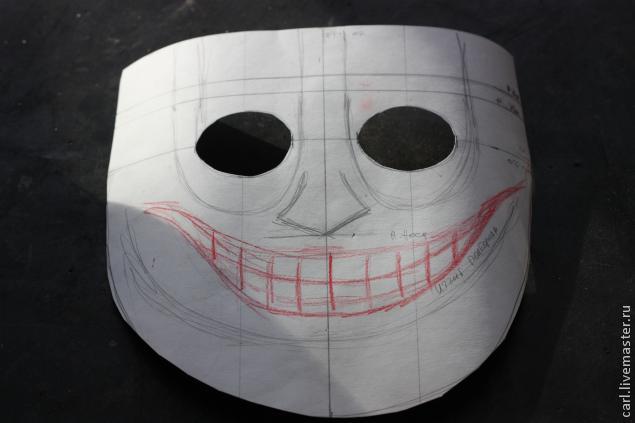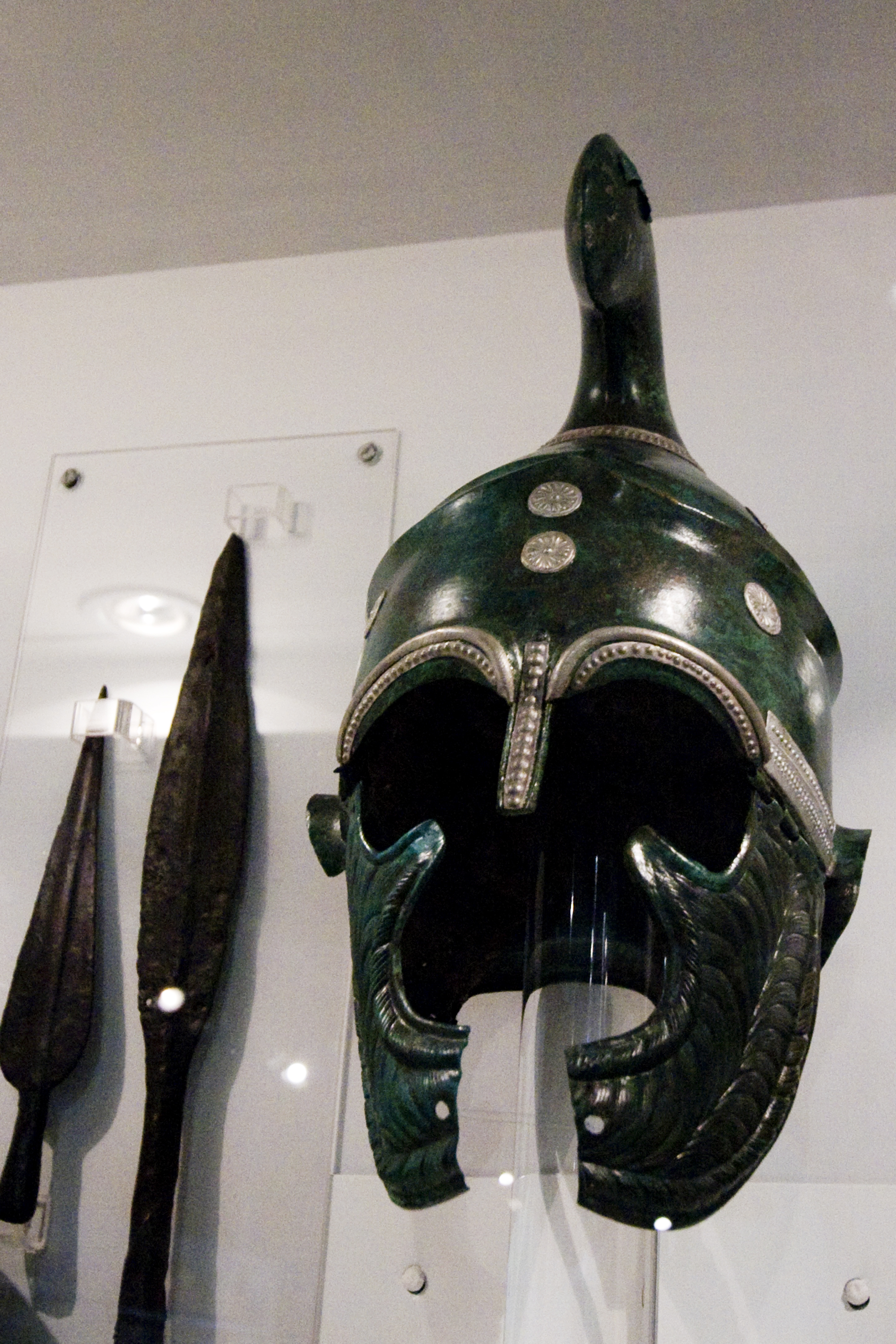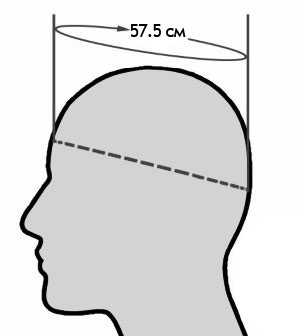Норманнский шлем. Норманнский шлем
Норманнский шлем — Википедия
 Норманнский шлем (реконструкция)
Норманнский шлем (реконструкция) Норма́ннский шлем, или Шлем с наносником, — тип средневекового открытого шлема конической, «яйцевидной» или сфероконической формы. Как правило, спереди крепилась металлическая назальная пластина — наносник. Могли изготавливаться как с бармицей, так и без неё. Были широко распространены в Западной и Восточной Европе с X по XIII—XIV век.
Содержание
В российской историографии данный тип шлема получил название норманнский по изображениям на ковре из Байё, посвящённым подготовке нормандского завоевания Англии и битве при Гастингсе[1], хотя на том же гобелене данный тип шлема используют и норманны, и англосаксы (например, сам Гарольд Годвинсон).
В западной историографии такой шлем получил название шлем с наносником (англ. Nasal helm). Название норманнский применительно к данному типу шлемов западными историками рассматривается как некорректное — в первую очередь потому, что он был распространён по всей Европе — как Западной, так и Восточной. Более того, в Скандинавии, откуда норманны пришли за полтора века до вторжения в Англию, такой шлем не был найден[2], хотя он и встречается в прикладном искусстве скандинавов (например, фигуры из шахматного набора с острова Льюис XII века и аналогичные артефакты из Тронхейма).
Представляли собой открытые шлемы, по форме могли быть коническими, «яйцевидными» или сферо-коническими (похожими на половину самопересекающегося тора с радиусом меньшим, чем радиус окружности, вращением которой он образуется). Такая форма шлема увеличивала защиту головы по сравнению с круглой формой и увеличивала площадь соскальзывания клинка.
Отличались невысокой тульёй, верхняя часть которой иногда образовывала небольшое заострение. Поначалу тулья состояла из нескольких частей металла (железа или меди), склёпанных между собой[2], что было продиктовано недостаточным уровнем развития технологии ковки сложных металлических изделий. В местах стыка часто устанавливали усиление в виде длинной и узкой металлической пластины по всему шву. Начиная с XI века, с развитием кузнечных технологий, появляются цельнокованые шлемы — в частности, известен русский шлем XI века из Немии[2] и европейские конца XI — начала XII веков[1].
Спереди на шлем, как правило, крепился массивный металлический наносник, расширявшийся книзу. Иногда наносник заменялся лицевой пластиной или полумаской[3], но известны варианты и вообще без наносника.
Также шлем мог снабжаться кольчужной бармицей, закрывавшей шею и плечи сзади, реже также и спереди, но иногда оставляя открытым лицо. Об этом, в частности, свидетельствует ряд отверстий у основания шлема, предназначенных как для крепления внутренней обивки, так и для крепления бармицы.
Аналогично топхельму «норманнский» шлем мог украшаться гербовыми цветами и нести нашлемник. Эта традиция наглядно показана на страницах эпических куплетов Liber ad honorem Augusti Питера Эболи[4]. Такая особенность встречается, например, на голландском шлеме из Мааса (Романо-германский Центральный музей, Майнц, Инв № 0.39806) — он выполнен без наносника, но имеет крепление для нашлемника.
Шлемы этого типа пришли в Европу с востока, согласно предположению Кирпичникова — через Русь или Восточную Европу.[2]
По Европе начинают распространяться примерно с IX века. Древнейшие шлемы относятся к X веку — это и чешский сферо-конический шлем короля Чехии св. Вацлава с наносником и русский конический шлем из Гнёздово без наносника, но с петлями для бармицы.
Шлем Вацлава — один из самых известных «норманнских» шлемов. Шлем составлен из тулии, датируемой X веком, и более позднего наносника, украшенного серебром. В таком виде он никогда не использовался в бою и был скорей предназначен для почитания святого.
Сохранились также и шлемы XI—XII веков, такие как чешский шлем из Оломоуца (Вена, Художественно-исторический музей, Инв. № HJRK A 41) и польский шлем с Ледницкого озера в Ледницком ландшафтном парке (Lednogóra, Muzeum НС Pierwszych Piastów Lednicy, Инв. № MPP 3/240/61/59).
В Европе шлемы часто надевались поверх кольчужного капюшона, но могли быть и с бармицей, в том числе защищавшей лицо. На Руси чаще снабжались кольчужной бармицей, закрывавшей сзади шею и плечи, реже — и спереди, но оставлявшей открытым лицо. Некоторые также имели наносник.
В XIII веке шлемы «норманнского» типа и их модификации теряют популярность и заменяются шлемами с большей защитой лица, но «норманнский» тип все же продолжают использовать примерно до XIV века по всей Европе.
- ↑ 1 2 Вендален Бехайм, «Энциклопедия оружия (Руководство по оружиеведению. Оружейное дело в его историческом развитии от начала средних веков до конца XVIII в.)».
- ↑ 1 2 3 4 Кирпичников А. Н., «Древнерусское оружие. Выпуск 3. Доспех, комплекс боевых средств IX—XIII вв.», Издательство «Наука», 1971.
- ↑ Скульптура в церкви Santa María la Real, Сангуэса, Навара, Испания. 1155 год.
- ↑ Иллюстрация из Liber ad honorem Augusti, показывающая одинаковые цвета и совпадение геометрии рисунка шлемов и щитов рыцарей, а также изображение креста на шлемах крестоносцев.
ru-m.wiki.ng
Норманнский шлем - WikiVisually
1. Средние века – In the history of Europe, the Middle Ages or Medieval Period lasted from the 5th to the 15th century. It began with the fall of the Western Roman Empire and merged into the Renaissance, the Middle Ages is the middle period of the three traditional divisions of Western history, classical antiquity, the medieval period, and the modern period. The medieval period is subdivided into the Early, High. Population decline, counterurbanisation, invasion, and movement of peoples, the large-scale movements of the Migration Period, including various Germanic peoples, formed new kingdoms in what remained of the Western Roman Empire. In the seventh century, North Africa and the Middle East—once part of the Byzantine Empire—came under the rule of the Umayyad Caliphate, although there were substantial changes in society and political structures, the break with classical antiquity was not complete. The still-sizeable Byzantine Empire survived in the east and remained a major power, the empires law code, the Corpus Juris Civilis or Code of Justinian, was rediscovered in Northern Italy in 1070 and became widely admired later in the Middle Ages. In the West, most kingdoms incorporated the few extant Roman institutions, monasteries were founded as campaigns to Christianise pagan Europe continued. The Franks, under the Carolingian dynasty, briefly established the Carolingian Empire during the later 8th, the Crusades, first preached in 1095, were military attempts by Western European Christians to regain control of the Holy Land from Muslims. Kings became the heads of centralised nation states, reducing crime and violence, intellectual life was marked by scholasticism, a philosophy that emphasised joining faith to reason, and by the founding of universities. Controversy, heresy, and the Western Schism within the Catholic Church paralleled the conflict, civil strife. Cultural and technological developments transformed European society, concluding the Late Middle Ages, the Middle Ages is one of the three major periods in the most enduring scheme for analysing European history, classical civilisation, or Antiquity, the Middle Ages, and the Modern Period. Medieval writers divided history into periods such as the Six Ages or the Four Empires, when referring to their own times, they spoke of them as being modern. In the 1330s, the humanist and poet Petrarch referred to pre-Christian times as antiqua, leonardo Bruni was the first historian to use tripartite periodisation in his History of the Florentine People. Bruni and later argued that Italy had recovered since Petrarchs time. The Middle Ages first appears in Latin in 1469 as media tempestas or middle season, in early usage, there were many variants, including medium aevum, or middle age, first recorded in 1604, and media saecula, or middle ages, first recorded in 1625. The alternative term medieval derives from medium aevum, tripartite periodisation became standard after the German 17th-century historian Christoph Cellarius divided history into three periods, Ancient, Medieval, and Modern. The most commonly given starting point for the Middle Ages is 476, for Europe as a whole,1500 is often considered to be the end of the Middle Ages, but there is no universally agreed upon end date. English historians often use the Battle of Bosworth Field in 1485 to mark the end of the period
2. Бармица – An aventail or camail is a flexible curtain of mail attached to the skull of a helmet that extends to cover the throat, neck and shoulders. Part or all of the face, with spaces to allow vision, the earliest camails were riveted directly to the edge of the helmet, however, beginning in the 1320s in Western Europe a detachable version replaced this type. The detachable aventail was attached to a band, which was in turn attached to the lower border of the helmet by a series of staples called vervelles. Holes in the band were passed over the vervelles. Aventails were most commonly seen on bascinets in the 14th century, some aventails were decorated with edging in brass or bronze links, or with a zig-zag lower edge. By the mid 14th century, the aventail had replaced the mail coif completely, the Routledge Companion to Medieval Warfare. Knight, Noble Warrior of England 1200–1600
3. Нормандское завоевание Англии – Williams claim to the English throne derived from his familial relationship with the childless Anglo-Saxon King Edward the Confessor, who may have encouraged Williams hopes for the throne. Edward died in January 1066 and was succeeded by his brother-in-law Harold Godwinson, within days, William landed in southern England. Harold marched south to confront him, leaving a significant portion of his army in the north, Harolds army confronted Williams invaders on 14 October at the Battle of Hastings, Williams force defeated Harold, who was killed in the engagement. Although Williams main rivals were gone, he faced rebellions over the following years and was not secure on his throne until after 1072. The lands of the resisting English elite were confiscated, some of the elite fled into exile, to control his new kingdom, William granted lands to his followers and built castles commanding military strongpoints throughout the land. More gradual changes affected the classes and village life, the main change appears to have been the formal elimination of slavery. There was little alteration in the structure of government, as the new Norman administrators took over many of the forms of Anglo-Saxon government. In 911 the Carolingian French ruler Charles the Simple allowed a group of Vikings under their leader Rollo to settle in Normandy as part of the Treaty of Saint-Clair-sur-Epte. In exchange for the land, the Norsemen under Rollo were expected to provide protection along the coast against further Viking invaders and their settlement proved successful, and the Vikings in the region became known as the Northmen from which Normandy and Normans are derived. The Normans quickly adopted the culture, renouncing paganism and converting to Christianity. They adopted the langue doïl of their new home and added features from their own Norse language, in 1002 King Æthelred the Unready married Emma of Normandy, the sister of Richard II, Duke of Normandy. Their son Edward the Confessor, who spent many years in exile in Normandy, childless and embroiled in conflict with the formidable Godwin, Earl of Wessex and his sons, Edward may also have encouraged Duke William of Normandys ambitions for the English throne. When King Edward died at the beginning of 1066, the lack of a clear heir led to a succession in which several contenders laid claim to the throne of England. Edwards immediate successor was the Earl of Wessex, Harold Godwinson, Harold was immediately challenged by two powerful neighbouring rulers. William and Harald at once set about assembling troops and ships to invade England, in early 1066, Harolds exiled brother, Tostig Godwinson, raided southeastern England with a fleet he had recruited in Flanders, later joined by other ships from Orkney. Threatened by Harolds fleet, Tostig moved north and raided in East Anglia and Lincolnshire, but he was back to his ships by the brothers Edwin, Earl of Mercia. Deserted by most of his followers, he withdrew to Scotland, King Harald Hardrada invaded northern England in early September, leading a fleet of more than 300 ships carrying perhaps 15,000 men. Haralds army was augmented by the forces of Tostig, who threw his support behind the Norwegian kings bid for the throne
4. Битва при Гастингсе – It took place approximately 7 miles northwest of Hastings, close to the present-day town of Battle, East Sussex, and was a decisive Norman victory. The background to the battle was the death of the childless King Edward the Confessor in January 1066, Harold was crowned king shortly after Edwards death, but faced invasions by William, his own brother Tostig and the Norwegian King Harald Hardrada. Hardrada and Tostig defeated a hastily gathered army of Englishmen at the Battle of Fulford on 20 September 1066, the deaths of Tostig and Hardrada at Stamford Bridge left William as Harolds only serious opponent. While Harold and his forces were recovering, William landed his forces in the south of England at Pevensey on 28 September 1066. Harold was forced to march south swiftly, gathering forces as he went, the exact numbers present at the battle are unknown, modern estimates are around 10,000 for William and about 7,000 for Harold. Harold appears to have tried to surprise William, but scouts found his army and reported its arrival to William, the battle lasted from about 9 am to dusk. Early efforts of the invaders to break the English battle lines had little effect, therefore, Harolds death, probably near the end of the battle, led to the retreat and defeat of most of his army. After further marching and some skirmishes, William was crowned as king on Christmas Day 1066, there continued to be rebellions and resistance to Williams rule, but Hastings effectively marked the culmination of Williams conquest of England. Casualty figures are hard to come by, but some estimate that 2,000 invaders died along with about twice that number of Englishmen. William founded a monastery at the site of the battle, the altar of the abbey church supposedly placed at the spot where Harold died. In 911, French Carolingian ruler Charles the Simple allowed a group of Vikings to settle in Normandy under their leader Rollo and their settlement proved successful, and they quickly adapted to the indigenous culture, renouncing paganism, converting to Christianity, and intermarrying with the local population. Over time, the frontiers of the duchy expanded to the west, in 1002, King Æthelred II of England married Emma, the sister of Richard II, Duke of Normandy. Their son Edward the Confessor spent many years in exile in Normandy, Edward was childless and embroiled in conflict with the formidable Godwin, Earl of Wessex and his sons, and he may also have encouraged Duke William of Normandys ambitions for the English throne. Following King Edwards death on 5 January 1066, the lack of a clear heir led to a succession in which several contenders laid claim to the throne of England. Edwards immediate successor was the Earl of Wessex, Harold Godwinson, Harold was at once challenged by two powerful neighbouring rulers. Duke William claimed that he had promised the throne by King Edward. Harald III of Norway, commonly known as Harald Hardrada, also contested the succession, William and Harald Hardrada immediately set about assembling troops and ships for separate invasions. In early 1066, Harolds exiled brother Tostig Godwinson raided south-eastern England with a fleet he had recruited in Flanders, threatened by Harolds fleet, Tostig moved north and raided in East Anglia and Lincolnshire
5. Норманны – The Normans were the people who, in the 10th and 11th centuries, gave their name to Normandy, a region in France. They were descended from Norse raiders and pirates from Denmark, Iceland and Norway who, under their leader Rollo, through generations of assimilation and mixing with the native Frankish and Gallo-Roman populations, their descendants gradually adopted the Carolingian-based cultures of West Francia. The distinct cultural and ethnic identity of the Normans emerged initially in the first half of the 10th century, the Norman dynasty had a major political, cultural and military impact on medieval Europe and even the Near East. The Normans were famed for their spirit and eventually for their Christian piety. They adopted the Gallo-Romance language of the Frankish land they settled, their becoming known as Norman, Normaund or Norman French. The Normans are noted both for their culture, such as their unique Romanesque architecture and musical traditions, and for their significant military accomplishments and their chief men were specially lavish through their desire of good report. They were, moreover, a race skillful in flattery, given to the study of eloquence, so that the boys were orators. They were enduring of toil, hunger, and cold whenever fortune laid it on them, given to hunting and hawking, delighting in the pleasure of horses, and of all the weapons and garb of war. The treaty offered Rollo and his men the French lands between the river Epte and the Atlantic coast in exchange for their protection against further Viking incursions. The area corresponded to the part of present-day Upper Normandy down to the river Seine. The territory was equivalent to the old province of Rouen. Before Rollos arrival, its populations did not differ from Picardy or the Île-de-France, the Norman language was forged by the adoption of the indigenous langue doïl branch of Romance by a Norse-speaking ruling class, and it developed into the regional language that survives today. The Normans thereafter adopted the growing feudal doctrines of the rest of France, the new Norman rulers were culturally and ethnically distinct from the old French aristocracy, most of whom traced their lineage to Franks of the Carolingian dynasty. Most Norman knights remained poor and land-hungry, and by 1066 Normandy had been exporting fighting horsemen for more than a generation, many Normans of Italy, France and England eventually served as avid Crusaders under the Italo-Norman prince Bohemund I and the Anglo-Norman king Richard the Lion-Heart. Opportunistic bands of Normans successfully established a foothold in Southern Italy, probably as the result of returning pilgrims stories, the Normans entered Southern Italy as warriors in 1017 at the latest. In 999, according to Amatus of Montecassino, Norman pilgrims returning from Jerusalem called in at the port of Salerno when a Saracen attack occurred. The Normans fought so valiantly that Prince Guaimar III begged them to stay, the Hauteville family achieved princely rank by proclaiming prince Guaimar IV of Salerno Duke of Apulia and Calabria. He promptly awarded their elected leader, William Iron Arm, with the title of count in his capital of Melfi
6. Англосаксы – The Anglo-Saxons are a people who have inhabited Great Britain from the 5th century. Historically, the Anglo-Saxon period denotes the period in Britain between about 450 and 1066, after their settlement and up until the Norman conquest. The early Anglo-Saxon period includes the creation of an English nation, with many of the aspects that survive today, including government of shires. During this period, Christianity was re-established and there was a flowering of literature, charters and law were also established. The term Anglo-Saxon is popularly used for the language that was spoken and written by the Anglo-Saxons in England, in scholarly use, it is more commonly called Old English. The history of the Anglo-Saxons is the history of a cultural identity and it developed from divergent groups in association with the peoples adoption of Christianity, and was integral to the establishment of various kingdoms. Threatened by extended Danish invasions and occupation of eastern England, this identity was re-established, the visible Anglo-Saxon culture can be seen in the material culture of buildings, dress styles, illuminated texts and grave goods. Behind the symbolic nature of these emblems, there are strong elements of tribal. The elite declared themselves as kings who developed burhs, and identified their roles and peoples in Biblical terms, above all, as Helena Hamerow has observed, local and extended kin groups remained. the essential unit of production throughout the Anglo-Saxon period. Use of the term Anglo-Saxon assumes that the words Angles, Saxons or Anglo-Saxon have the meaning in all the sources. Assigning ethnic labels such as Anglo-Saxon is fraught with difficulties and this term began to be used only in the 8th century to distinguish the Germanic groups in Britain from those on the continent. The Old English ethnonym Angul-Seaxan comes from the Latin Angli-Saxones and became the name of the peoples Bede calls Anglorum, Anglo-Saxon is a term that was rarely used by Anglo-Saxons themselves, it is not an autonym. It is likely they identified as ængli, Seaxe or, more probably, also, the use of Anglo-Saxon disguises the extent to which people identified as Anglo-Scandinavian after the Viking age or the conquest of 1016, or as Anglo-Norman after the Norman conquest. The earliest historical references using this term are from outside Britain, referring to piratical Germanic raiders, Saxones who attacked the shores of Britain, procopius states that Britain was settled by three races, the Angiloi, Frisones, and Britons. The term Angli Saxones seems to have first been used in writing of the 8th century. The name therefore seemed to mean English Saxons, the Christian church seems to have used the word Angli, for example in the story of Pope Gregory I and his remark, Non Angli sed angeli. The terms ænglisc and Angelcynn were also used by West Saxon King Alfred to refer to the people, at other times he uses the term rex Anglorum, which presumably meant both Anglo-Saxons and Danes. Alfred the Great used Anglosaxonum Rex, the term Engla cyningc is used by Æthelred
7. Шахматы с острова Льюис – When found, the hoard contained 93 artifacts,78 chess pieces,14 tablemen and one belt buckle. Today,82 pieces are owned and usually exhibited by the British Museum in London, the British Museum claims the chessmen were probably made in Trondheim, Norway, in the 12th century, although some scholars have suggested other Nordic countries. During that period, the Outer Hebrides, along other major groups of Scottish islands, were ruled by Norway. The presence of people in Trondheim able to pay craftsmen for high-quality chess pieces. Similar carving in Nidaros Cathedral in Trondheim, the excavation in Trondheim of a kite-shaped shield similar to shields on some of the pieces and a king piece of similar design found on Hitra Island, near the mouth of Trondheim Fjord. Woolf has said that the worn by the chess figures includes perfect reproductions of armour worn at the time in Norway. They further claim that the pieces were carved by an artist known as Margret the Adroit, however, this is disputed by Woolf, who stated that the use of bishops originated in England, and by Norwegian chess historian and member of the Ken Whyld Association Morten Lilleøren. Some historians believe that the Lewis chessmen were hidden after some mishap occurred during their carriage from Norway to wealthy Norse towns on the east coast of Ireland, the large number of pieces and their lack of wear may suggest that they were the stock of a trader or dealer. Along with the pieces, there were 14 plain round tablemen for the game of tables and one belt buckle, all made of ivory. Almost all of the pieces in the collection are carved from walrus ivory, the 78 pieces consist of eight kings, eight queens,16 bishops,15 knights,12 rooks and 19 pawns. The heights of the range from 3.5 to 5.8 cm. Although there are 19 pawns, they have the greatest range of sizes of all the pieces, all the pieces are sculptures of human figures, with the exception of the pawns, which are smaller, geometric shapes. The knights are mounted on rather diminutive horses and are shown holding spears, the rooks are standing soldiers or warders holding shields and swords, four of the rooks are shown as wild-eyed berserkers biting their shields with battle fury. Some pieces bore traces of red stain when found, indicating that red, scholars have observed that, to the modern eye, the figural pieces, with their bulging eyes and glum expressions, have a distinct comical character. This is especially true of the rook with a worried, sideways glance and the berserkers biting their shields. The chessmen were discovered in early 1831 in a bank at the head of Camas Uig on the west coast of the Isle of Lewis. There are various stories concerning their arrival and modern discovery on Lewis. Malcolm Sport MacLeod from the township of Pennydonald discovered the trove in a small stone kist in a dune, exhibited them briefly in his byre
8. Тронхейм – Trondheim, historically Kaupangen, Nidaros and Trondhjem, is a city and municipality in Sør-Trøndelag county, Norway. It has a population of 187,353, and is the third most populous municipality in Norway and it is the third largest city in the country, with a population of 169,972 inhabitants within the city borders. The city functions as the centre of Sør-Trøndelag county. Trondheim lies on the shore of Trondheim Fjord at the mouth of the river Nidelva. The settlement was founded in 997 as a trading post, from 1152 to 1537, the city was the seat of the Catholic Archdiocese of Nidaros, since then, it has remained the seat of the Lutheran Diocese of Nidaros and the Nidaros Cathedral. The current municipality dates from 1964, when Trondheim merged with Byneset, Leinstrand, Strinda, for the ecclesiastical history, see Archiepiscopate of Nidaros Trondheim was named Kaupangen by Viking King Olav Tryggvason in 997. Shortly thereafter it came to be called Nidaros, in the beginning it was frequently used as a military retainer of King Olav I. It was frequently used as the seat of the king, and was the capital of Norway until 1217, people have been living in the region for thousands of years as evidenced by the rock carvings in central Norway, the Nøstvet and Lihult cultures and the Corded Ware culture. In ancient times, the Kings of Norway were hailed at Øretinget in Trondheim, Harald Fairhair was hailed as the king here, as was his son, Haakon I, called the Good. The battle of Kalvskinnet took place in Trondheim in 1179, King Sverre Sigurdsson, some scholars believe that the famous Lewis chessmen, 12th-century chess pieces carved from walrus ivory found in the Hebrides and now at the British Museum, may have been made in Trondheim. Trondheim was the seat of the Archdiocese of Nidaros for Norway from 1152, due to the introduction of Lutheran Protestantism in 1537, the last Archbishop, Olav Engelbrektsson, had to flee from the city to the Netherlands, where he died in present-day Lier, Belgium. The city has experienced major fires. Since much of the city was made of wooden buildings, many of the fires caused severe damage. Great fires ravaged the city in 1598,1651,1681,1708, twice in 1717,1742,1788,1841 and 1842, however, the 1651 fire destroyed 90% of all buildings within the city limits. The fire in 1681 led to an almost total reconstruction of the city, overseen by General Johan Caspar von Cicignon, broad avenues like Munkegaten were created, with no regard for property rights, in order to stop the next fire. At the time, the city had a population of roughly 8000 inhabitants, after the Treaty of Roskilde on 26 February 1658, Trondheim and the rest of Trøndelag, became Swedish territory for a brief period, but the area was reconquered 10 months later. The conflict was settled by the Treaty of Copenhagen on 27 May 1660. During World War II, Trondheim was occupied by Nazi Germany from 9 April 1940, the home of the most notorious Norwegian Gestapo agent, Henry Rinnan, was in Trondheim
9. Музей истории искусств – The Kunsthistorisches Museum is an art museum in Vienna, Austria. Housed in its festive palatial building on Ringstraße, it is crowned with an octagonal dome, the term Kunsthistorisches Museum applies to both the institution and the main building. It is the largest art museum in the country and it was opened around 1891 at the same time as the Naturhistorisches Museum, by Emperor Franz Joseph I of Austria-Hungary. The two museums have similar exteriors and face each other across Maria-Theresien-Platz, both buildings were built between 1871 and 1891 according to plans drawn up by Gottfried Semper and Karl Freiherr von Hasenauer. The two Ringstraße museums were commissioned by the Emperor in order to find a shelter for the Habsburgs formidable art collection. The façade was built of sandstone, the building is rectangular in shape, and topped with a dome that is 60 meters high. The inside of the building is decorated with marble, stucco ornamentations, gold-leaf. It was featured in an episode of Museum Secrets on the History Channel and it had been the biggest art theft in Austrian history. Treasure of Nagyszentmiklós Media related to Kunsthistorisches Museum at Wikimedia Commons Official website Spherical panorama of entrance Hofburgs Armory - photo gallery in Flickr
10. Тор (поверхность) – In geometry, a torus is a surface of revolution generated by revolving a circle in three-dimensional space about an axis coplanar with the circle. If the axis of revolution does not touch the circle, the surface has a shape and is called a torus of revolution. Real-world examples of objects include inner tubes, swim rings, and the surface of a doughnut. A torus should not be confused with a solid torus, which is formed by rotating a disc, rather than a circle, a solid torus is a torus plus the volume inside the torus. Real-world approximations include doughnuts, vadai or vada, many lifebuoys, in topology, a ring torus is homeomorphic to the Cartesian product of two circles, S1 × S1, and the latter is taken to be the definition in that context. It is a compact 2-manifold of genus 1, the ring torus is one way to embed this space into three-dimensional Euclidean space, but another way to do this is the Cartesian product of the embedding of S1 in the plane. This produces an object called the Clifford torus, a surface in 4-space. In the field of topology, a torus is any space that is topologically equivalent to a torus. R is known as the radius and r is known as the minor radius. The ratio R divided by r is known as the aspect ratio, a doughnut has an aspect ratio of about 2 to 3. An implicit equation in Cartesian coordinates for a torus radially symmetric about the z-axis is 2 + z 2 = r 2, or the solution of f =0, algebraically eliminating the square root gives a quartic equation,2 =4 R2. The three different classes of standard tori correspond to the three aspect ratios between R and r, When R > r, the surface will be the familiar ring torus. R = r corresponds to the torus, which in effect is a torus with no hole. R < r describes the self-intersecting spindle torus, when R =0, the torus degenerates to the sphere. When R ≥ r, the interior 2 + z 2 < r 2 of this torus is diffeomorphic to a product of an Euclidean open disc, the losses in surface area and volume on the inner side of the tube exactly cancel out the gains on the outer side. In traditional spherical coordinates there are three measures, R, the distance from the center of the system, and θ and φ. As a torus has, effectively, two points, the centerpoints of the angles are moved, φ measures the same angle as it does in the spherical system. The center point of θ is moved to the center of r and these terms were first used in a discussion of the Earths magnetic field, where poloidal was used to denote the direction toward the poles
wikivisually.com
WikiZero - Норманнский шлем
Open wikipedia design.
 Норманнский шлем (реконструкция)
Норманнский шлем (реконструкция) Норма́ннский шлем, или Шлем с наносником, — тип средневекового открытого шлема конической, «яйцевидной» или сфероконической формы. Как правило, спереди крепилась металлическая назальная пластина — наносник. Могли изготавливаться как с бармицей, так и без неё. Были широко распространены в Западной и Восточной Европе с X по XIII—XIV век.

В российской историографии данный тип шлема получил название норманнский по изображениям на ковре из Байё, посвящённым подготовке нормандского завоевания Англии и битве при Гастингсе[1], хотя на том же гобелене данный тип шлема используют и норманны, и англосаксы (например, сам Гарольд Годвинсон).
В западной историографии такой шлем получил название шлем с наносником (англ. Nasal helm). Название норманнский применительно к данному типу шлемов западными историками рассматривается как некорректное — в первую очередь потому, что он был распространён по всей Европе — как Западной, так и Восточной. Более того, в Скандинавии, откуда норманны пришли за полтора века до вторжения в Англию, такой шлем не был найден[2], хотя он и встречается в прикладном искусстве скандинавов (например, фигуры из шахматного набора с острова Льюис XII века и аналогичные артефакты из Тронхейма).

Представляли собой открытые шлемы, по форме могли быть коническими, «яйцевидными» или сферо-коническими (похожими на половину самопересекающегося тора с радиусом меньшим, чем радиус окружности, вращением которой он образуется). Такая форма шлема увеличивала защиту головы по сравнению с круглой формой и увеличивала площадь соскальзывания клинка.
Отличались невысокой тульёй, верхняя часть которой иногда образовывала небольшое заострение. Поначалу тулья состояла из нескольких частей металла (железа или меди), склёпанных между собой[2], что было продиктовано недостаточным уровнем развития технологии ковки сложных металлических изделий. В местах стыка часто устанавливали усиление в виде длинной и узкой металлической пластины по всему шву. Начиная с XI века, с развитием кузнечных технологий, появляются цельнокованые шлемы — в частности, известен русский шлем XI века из Немии[2] и европейские конца XI — начала XII веков[1].
Спереди на шлем, как правило, крепился массивный металлический наносник, расширявшийся книзу. Иногда наносник заменялся лицевой пластиной или полумаской[3], но известны варианты и вообще без наносника.
Также шлем мог снабжаться кольчужной бармицей, закрывавшей шею и плечи сзади, реже также и спереди, но иногда оставляя открытым лицо. Об этом, в частности, свидетельствует ряд отверстий у основания шлема, предназначенных как для крепления внутренней обивки, так и для крепления бармицы.
Аналогично топхельму «норманнский» шлем мог украшаться гербовыми цветами и нести нашлемник. Эта традиция наглядно показана на страницах эпических куплетов Liber ad honorem Augusti Питера Эболи[4]. Такая особенность встречается, например, на голландском шлеме из Мааса (Романо-германский Центральный музей, Майнц, Инв № 0.39806) — он выполнен без наносника, но имеет крепление для нашлемника.

Шлемы этого типа пришли в Европу с востока, согласно предположению Кирпичникова — через Русь или Восточную Европу.[2]
По Европе начинают распространяться примерно с IX века. Древнейшие шлемы относятся к X веку — это и чешский сферо-конический шлем короля Чехии св. Вацлава с наносником и русский конический шлем из Гнёздово без наносника, но с петлями для бармицы.
Шлем Вацлава — один из самых известных «норманнских» шлемов. Шлем составлен из тулии, датируемой X веком, и более позднего наносника, украшенного серебром. В таком виде он никогда не использовался в бою и был скорей предназначен для почитания святого.
Сохранились также и шлемы XI—XII веков, такие как чешский шлем из Оломоуца (Вена, Художественно-исторический музей, Инв. № HJRK A 41) и польский шлем с Ледницкого озера в Ледницком ландшафтном парке (Lednogóra, Muzeum НС Pierwszych Piastów Lednicy, Инв. № MPP 3/240/61/59).
В Европе шлемы часто надевались поверх кольчужного капюшона, но могли быть и с бармицей, в том числе защищавшей лицо. На Руси чаще снабжались кольчужной бармицей, закрывавшей сзади шею и плечи, реже — и спереди, но оставлявшей открытым лицо. Некоторые также имели наносник.
В XIII веке шлемы «норманнского» типа и их модификации теряют популярность и заменяются шлемами с большей защитой лица, но «норманнский» тип все же продолжают использовать примерно до XIV века по всей Европе.
- ↑ 1 2 Вендален Бехайм, «Энциклопедия оружия (Руководство по оружиеведению. Оружейное дело в его историческом развитии от начала средних веков до конца XVIII в.)».
- ↑ 1 2 3 4 Кирпичников А. Н., «Древнерусское оружие. Выпуск 3. Доспех, комплекс боевых средств IX—XIII вв.», Издательство «Наука», 1971.
- ↑ Скульптура в церкви Santa María la Real, Сангуэса, Навара, Испания. 1155 год.
- ↑ Иллюстрация из Liber ad honorem Augusti, показывающая одинаковые цвета и совпадение геометрии рисунка шлемов и щитов рыцарей, а также изображение креста на шлемах крестоносцев.
www.wikizero.com
Норманнский шлем - Howling Pixel
Норма́ннский шлем, или Шлем с наносником, — тип средневекового открытого шлема конической, «яйцевидной» или сфероконической формы. Как правило, спереди крепилась металлическая назальная пластина — наносник. Могли изготавливаться как с бармицей, так и без неё. Были широко распространены в Западной и Восточной Европе с X по XIII—XIV век.
Название
В российской историографии данный тип шлема получил название норманнский по изображениям на ковре из Байё, посвящённым подготовке нормандского завоевания Англии и битве при Гастингсе[1], хотя на том же гобелене данный тип шлема используют и норманны, и англосаксы (например, сам Гарольд Годвинсон).
В западной историографии такой шлем получил название шлем с наносником (англ. Nasal helm). Название норманнский применительно к данному типу шлемов западными историками рассматривается как некорректное — в первую очередь потому, что он был распространён по всей Европе — как Западной, так и Восточной. Более того, в Скандинавии, откуда норманны пришли за полтора века до вторжения в Англию, такой шлем не был найден[2], хотя он и встречается в прикладном искусстве скандинавов (например, фигуры из шахматного набора с острова Льюис XII века и аналогичные артефакты из Тронхейма).
Внешний вид
Представляли собой открытые шлемы, по форме могли быть коническими, «яйцевидными» или сферо-коническими (похожими на половину самопересекающегося тора с радиусом меньшим, чем радиус окружности, вращением которой он образуется). Такая форма шлема увеличивала защиту головы по сравнению с круглой формой и увеличивала площадь соскальзывания клинка.
Отличались невысокой тульёй, верхняя часть которой иногда образовывала небольшое заострение. Поначалу тулья состояла из нескольких частей металла (железа или меди), склёпанных между собой[2], что было продиктовано недостаточным уровнем развития технологии ковки сложных металлических изделий. В местах стыка часто устанавливали усиление в виде длинной и узкой металлической пластины по всему шву. Начиная с XI века, с развитием кузнечных технологий, появляются цельнокованые шлемы — в частности, известен русский шлем XI века из Немии[2] и европейские конца XI — начала XII веков[1].
Спереди на шлем, как правило, крепился массивный металлический наносник, расширявшийся книзу. Иногда наносник заменялся лицевой пластиной или полумаской[3], но известны варианты и вообще без наносника.
Также шлем мог снабжаться кольчужной бармицей, закрывавшей шею и плечи сзади, реже также и спереди, но иногда оставляя открытым лицо. Об этом, в частности, свидетельствует ряд отверстий у основания шлема, предназначенных как для крепления внутренней обивки, так и для крепления бармицы.
Аналогично топхельму «норманнский» шлем мог украшаться гербовыми цветами и нести нашлемник. Эта традиция наглядно показана на страницах эпических куплетов Liber ad honorem Augusti Питера Эболи[4]. Такая особенность встречается, например, на голландском шлеме из Мааса (Романо-германский Центральный музей, Майнц, Инв № 0.39806) — он выполнен без наносника, но имеет крепление для нашлемника.
История
Шлемы этого типа пришли в Европу с востока, согласно предположению Кирпичникова — через Русь или Восточную Европу.[2]
По Европе начинают распространяться примерно с IX века. Древнейшие шлемы относятся к X веку — это и чешский сферо-конический шлем короля Чехии св. Вацлава с наносником и русский конический шлем из Гнёздово без наносника, но с петлями для бармицы.
Шлем Вацлава — один из самых известных «норманнских» шлемов. Шлем составлен из тулии, датируемой X веком, и более позднего наносника, украшенного серебром. В таком виде он никогда не использовался в бою и был скорей предназначен для почитания святого.
Сохранились также и шлемы XI—XII веков, такие как чешский шлем из Оломоуца (Вена, Художественно-исторический музей, Инв. № HJRK A 41) и польский шлем с Ледницкого озера в Ледницком ландшафтном парке (Lednogóra, Muzeum НС Pierwszych Piastów Lednicy, Инв. № MPP 3/240/61/59).
В Европе шлемы часто надевались поверх кольчужного капюшона, но могли быть и с бармицей, в том числе защищавшей лицо. На Руси чаще снабжались кольчужной бармицей, закрывавшей сзади шею и плечи, реже — и спереди, но оставлявшей открытым лицо. Некоторые также имели наносник.
В XIII веке шлемы «норманнского» типа и их модификации теряют популярность и заменяются шлемами с большей защитой лица, но «норманнский» тип все же продолжают использовать примерно до XIV века по всей Европе.
Примечания
- ↑ 1 2 Вендален Бехайм, «Энциклопедия оружия (Руководство по оружиеведению. Оружейное дело в его историческом развитии от начала средних веков до конца XVIII в.)».
- ↑ 1 2 3 4 Кирпичников А. Н., «Древнерусское оружие. Выпуск 3. Доспех, комплекс боевых средств IX—XIII вв.», Издательство «Наука», 1971.
- ↑ Скульптура в церкви Santa María la Real, Сангуэса, Навара, Испания. 1155 год.
- ↑ Иллюстрация из Liber ad honorem Augusti, показывающая одинаковые цвета и совпадение геометрии рисунка шлемов и щитов рыцарей, а также изображение креста на шлемах крестоносцев.
См. также
This page is based on a Wikipedia article written by authors (here). Text is available under the CC BY-SA 3.0 license; additional terms may apply. Images, videos and audio are available under their respective licenses.
howlingpixel.com
Норманнский шлем - Википедия
 Норманнский шлем (реконструкция)
Норманнский шлем (реконструкция) Норма́ннский шлем, или Шлем с наносником — тип средневекового открытого шлема конической, «яйцевидной» или сфероконической формы. Как правило, спереди крепилась металлическая назальная пластина — наносник. Могли изготавливаться как с бармицей, так и без неё. Были широко распространены в Западной и Восточной Европе с X по XIII—XIV век.
Название[ | ]

В российской историографии данный тип шлема получил название норманнский по изображениям на ковре из Байё, посвящённым подготовке нормандского завоевания Англии и битве при Гастингсе[1], хотя на том же гобелене данный тип шлема используют и норманны, и англосаксы (например, сам Гарольд Годвинсон).
В западной историографии такой шлем получил название шлем с наносником (англ. Nasal helm). Название норманнский применительно к данному типу шлемов западными историками рассматривается как некорректное — в первую очередь потому, что он был распространён по всей Европе — как Западной, так и Восточной. Более того, в Скандинавии, откуда норманны пришли за полтора века до вторжения в Англию, такой шлем не был найден[2], хотя он и встречается в прикладном искусстве скандинавов (например, фигуры из шахматного набора с острова Льюис XII века и аналогичные артефакты из Тронхейма).
Внешний вид[ | ]

Представляли собой открытые шлемы, по форме могли быть коническими, «яйцевидными» или сферо-коническими (похожими на половину самопересекающегося тора с радиусом меньшим, чем радиус окружности, вращением которой он образуется). Такая форма шлема увеличивала защиту головы по сравнению с круглой формой и увеличивала площадь соскальзывания клинка.
Отличались невысокой тульёй, верхняя часть которой иногда образовывала небольшое заострение. Поначалу тулья состояла из нескольких частей металла (железа или меди), склёпанных между собой[2], что было продиктовано недостаточным уровнем развития технологии ковки сложных металлических изделий. В местах стыка часто устанавливали усиление в виде длинной и узкой металлической пластины по всему шву. Начиная с XI века, с развитием кузнечных технологий, появляются цельнокованые шлемы — в частности, известен русский шлем XI века из Немии[2] и европейские конца XI — начала XII веков[1].
Спереди на шлем, как правило, крепился массивный металлический наносник, расширявшийся книзу. Иногда наносник заменялся лицевой пластиной или полумаской[3], но известны варианты и вообще без наносника.
Также шлем мог снабжаться кольчужной бармицей, закрывавшей шею и плечи сзади, реже также и спереди, но иногда оставляя открытым лицо. Об этом, в частности, свидетельствует ряд отверстий у основания шлема, предназначенных как для крепления внутренней обивки, так и для крепления бармицы.
Аналогично топхельму «норманнский» шлем мог украшаться гербовыми цветами и нести нашлемник. Эта традиция наглядно показана на страницах эпических куплетов Питера Эболи[4]. Такая особенность встречается, например, на голландском шлеме из Мааса (Романо-германский Центральный музей, Майнц, Инв № 0.39806) — он выполнен без наносника, но имеет крепление для нашлемника.
История[ | ]

Шлемы этого типа пришли в Европу с востока, согласно предположению Кирпичникова — через Русь или Восточную Европу.[2]
По Европе начинают распространяться примерно с IX века. Древнейшие шлемы относятся к X веку — это и чешский сферо-конический шлем короля Чехии св. Вацлава с наносником и русский конический шлем из Гнёздово без наносника, но с петлями для бармицы.
Шлем Вацлава — один из самых известных «норманнских» шлемов. Шлем составлен из тулии, датируемой X веком, и более позднего наносника, украшенного серебром. В таком виде он никогда не использовался в бою и был скорей предназначен для почитания святого.
Сохранились также и шлемы XI—XII веков, такие как чешский шлем из Оломоуца (Вена, Художественно-исторический музей, Инв. № HJRK A 41) и польский шлем с Ледницкого озера в Ледницком ландшафтном парке (Lednogóra, Muzeum НС Pierwszych Piastów Lednicy, Инв. № MPP 3/240/61/59).
В Европе шлемы часто надевались поверх кольчужного капюшона, но могли быть и с бармицей, в том числе защищавшей лицо. На Руси чаще снабжались кольчужной бармицей, закрывавшей сзади шею и плечи, реже — и спереди, но оставлявшей открытым лицо. Некоторые также имели наносник.
В XIII веке шлемы «норманнского» типа и их модификации теряют популярность и заменяются шлемами с большей защитой лица, но «норманнский» тип все же продолжают использовать примерно до XIV века по всей Европе.
Примечания[ | ]
- ↑ 1 2 Вендален Бехайм, «Энциклопедия оружия (Руководство по оружиеведению. Оружейное дело в его историческом развитии от начала средних веков до конца XVIII в.)».
- ↑ 1 2 3 4 Кирпичников А. Н., «Древнерусское оружие. Выпуск 3. Доспех, комплекс боевых средств IX—XIII вв.», Издательство «Наука», 1971.
- ↑ Скульптура в церкви Santa María la Real, Сангуэса, Навара, Испания. 1155 год.
- ↑ Иллюстрация из Liber ad honorem Augusti, показывающая и шлемов и щитов рыцарей, а также .
См. также[ | ]
encyclopaedia.bid
Реферат Норманнский шлем
скачатьРеферат на тему:
План:
- Введение
- 1 Название
- 2 Внешний вид
- 3 История Примечания
Введение
Норманнский шлем (реконструкция)
Норма́ннский шлем или Шлем с наносником — тип средневекового открытого шлема конической, «яйцевидной» или сфероконической формы. Как правило, спереди крепился металический наносник. Могли изготавливаться как с бармицей так и без. Широко были распространены в Западной и Восточной Европе с X по XIII—XIV век.
1. Название
Норманнские войны на ковре из Байё.
В руссийской историографии данный тип шлема получил название норманнский по изображениям на ковре из Байё, посвященному подготовке нормандского завоевания Англии и битве при Гастингсе[1]. Название норманнский он получил несмотря на то, что на том же гобелене данный тип шлема в равной степени используют и англосаксонские (наприме, сам Гарольд Годвинсон представлен в нем) и норманнские воины.
В западной историографии данный тип получил название шлем с наносником (англ. Nasal helm). Название норманнский применительно к данному типу шлемов западными историками рассматривается как неверный, в первую очередь потому, что данный тип шлема имел широкое хождение по всей Европе как Западной, так и Восточной. Более того в Скандинавии, откуда нораманны пришли за полтора века до вторжения в Англию, подобный тип шлема не был найден[2], хотя и встречается в прикладном искусстве скандинавов (например, фигуры из Шахматы с острова Льюис XII века и аналогичных артефактов из Тронхейма).
2. Внешний вид
Моравский шлем XI века.Музей истории искусств.
Представляли собой открытые шлемы, по форме могли быть коническими, «яйцевидными» или сфероконическими (похожими на половину самопересекающегося тора с радиусом, меньшим, чем радиус окружности, вращением которой он образуется). Такая форма шлема увеличивала защиту головы по сравнению с круглой формой и увеличивала площадь соскальзывания клинка.
Отличались невысокой тульёй, верхняя часть которой иногда образовывала небольшое заострение. Поначалу тулия состояла из нескольких частей металла (железа или меди), склёпанных между собой[2], что было продиктовано недостаточным уровнем развития технологии ковки сложных металических изделий. В местах стыка часто устанавливали усиление в виде длинной и узкой металической пластины по всему шву. Начиная с XI века, с развитием кузнечных технологий, появляются цельнокованные шлемы — в частности, известен русский шлем XI века из Немии[2] и европейские конца XI — начала XII веков[1].
Спереди на шлем, как правило, крепился массивный металический наносник, расширявшимся к низу. Иногда наносник заменялся лицевой пластиной или полумаской[3], но известны варианты и вообще без наносника.
Также шлем мог снабжаться кольчужной бармицей, закрывавшей шею и плечи сзади, реже также и спереди, но иногда оставляя открытым лицо. Об этом в том числе свидетельствует ряд отверстий у снования шлема, предназначенные как для крепления внутренней обивки так и для крепления бармицы.
Аналогично топхельму «норманнский» шлем мог украшаться гербовыми цветами и нести нашлемник. Эта традиция наглядна показана на страницах эпических куплетов Liber ad honorem Augusti Питера Эболи[4]. Такая особенность встречается, например, на голандском шлеме из Мааса (Романо-германской Центральный музей, Майнц, Инв № 0.39806) — он выполнен без наносника, но имеет крепление для нашлемника.
3. История
Шлем св. Вацлава
Подобные шлемы в Европу пришли с востока, согласно предположению Кирпичникова — посредством Руси или Восточной Европы.[2]
По Европе начинают распространяться примерно с IX века. Древнейшие шлемы относятся к X веку — это и чешский сфероконический шлем короля Чехии св. Вацлава с наносником и русский конический шлем из Гнездово без наносника, но с петлями для бармицы.
Шлем Вацлава — один из самых известных «норманнских» шлемов. Шлем составлен из тулии, датируемой X веком, и более поздним наносником, украшенным серебром. В таком виде он никогда не использовался в бою и был скорей предназначен для почитания святого.
Сохранились также и шлемы XI-XII веков такие как — чешский шлем из Оломоуца (Вена Художественно-исторический музей, Инв № HJRK A 41) и польский шлем с Ледницкого озера (Lednogóra, Muzeum НС Pierwszych Piastów Lednicy, Инв № MPP 3/240/61/59).
В Европе шлемы часто надевались поверх кольчужного капюшона, но могли быть и с бармицей, в том числе — защищавшей лицо. На Руси чаще снабжались кольчужной бармицей, закрывавшей сзади шею и плечи, а реже — и спереди, но оставлявшей открытым лицо. Некоторые так же имели наносник.
В XIII веке шлемы «норманнского» типа и их модификации теряют популярность и заменяются шлемами с большей защитой лица, но «норманнский» тип все же продолжают использовать примерно до XIV века по всей Европе.
Примечания
- ↑ 12 Вендален Бехайм, «Энциклопедия оружия (Руководство по оружиеведению. Оружейное дело в его историческом развитии от начала средних веков до конца XVIII в.)».
- ↑ 1234 Кирпичников А. Н., «Древнерусское оружие. Выпуск 3. Доспех, комплекс боевых средств IX—XIII вв.», Издательство «Наука», 1971.
- Скульптура в церкви - smhospital.fatal.ru/HISTORY/helmet.files/normanka_4.jpg Santa María la Real, Сангуэса, Навара, Испания. 1155 год.
- Иллюстрация из Liber ad honorem Augusti, показывающие одинаковые цвета и совпадение геометрии рисунка шлемов и щитов рыцарей, а также изображение креста на шлемах крестоносцев.
wreferat.baza-referat.ru

















